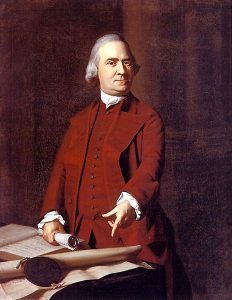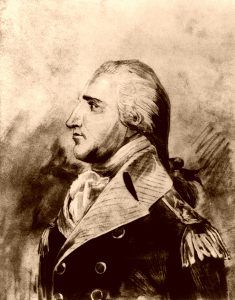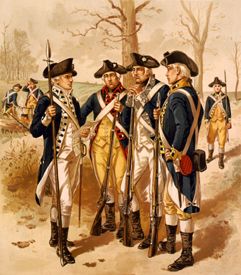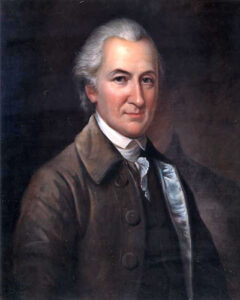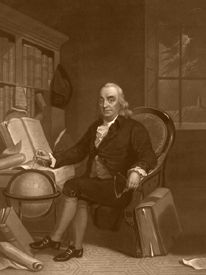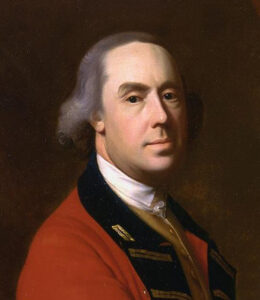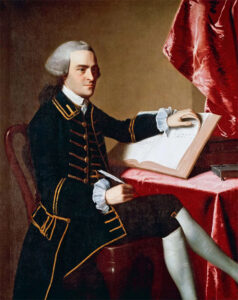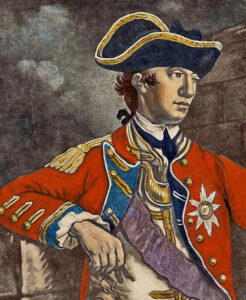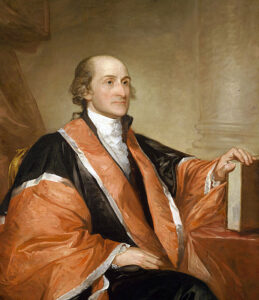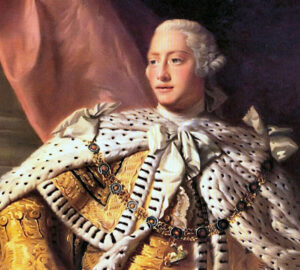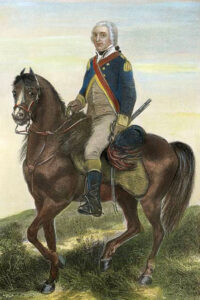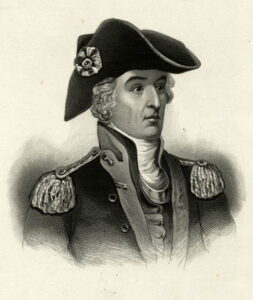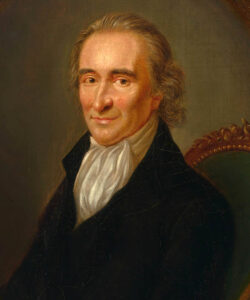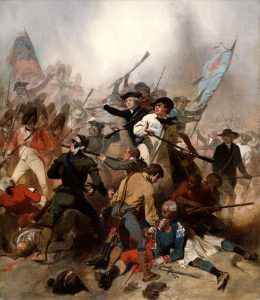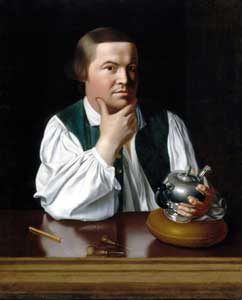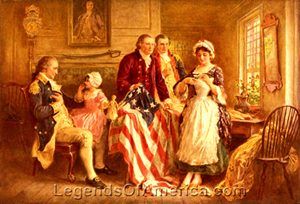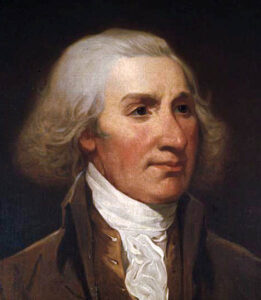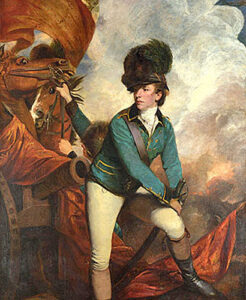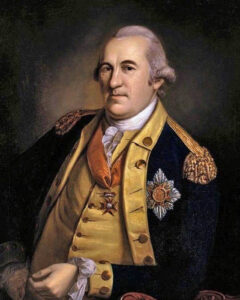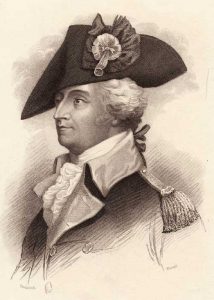From the founding fathers to soldiers, camp followers, wives, and military leaders, there were numerous heroes of the American Revolution.
John Adams (1735-1826) was the spokesman for the American Revolution, playing a central role in convincing the Continental Congress to vote for independence. He worked with Thomas Jefferson and Benjamin Franklin to write the Declaration of Independence. He also served as a diplomat in the Netherlands and Britain before eventually becoming the second President of the United States.
Samuel Adams (1722-1803) was an American statesman, political philosopher, and Founding Father of the United States. He was a leading speaker and coordinator behind American resistance to British economic tyranny and one of the figures at the Continental Congress who pushed for complete independence from Britain. After the war, he became governor of Massachusetts. He was also a cousin of the second President John Adams.
Ethan Allen (1738-1789) was an American soldier during the Revolutionary War known for capturing Fort Ticonderoga in 1775 and later being one of the founders of the state of Vermont.
Benedict Arnold (1741-1801), the man whose name became synonymous with the word “traitor” in the United States, was also one of the nation’s most brilliant tacticians of his day. He defected from the Continental Army to the British for money to pay his debts. He planned to betray control of West Point, New York, to the British but fled to them after the plan was discovered. He died in debt in London in 1801.
Crispus Attucks, the first victim of the Boston Massacre, became a symbol of the Black freedom struggle in the United States.
Nathaniel Bacon (1647-1676) – Nathaniel Bacon was an English merchant adventurer who emigrated to the Virginia Colony, where he sat on the Governor’s Council but later led Bacon’s Rebellion. The Rebellion was briefly successful, but the rebel forces collapsed after Bacon’s death from dysentery.
Nisbet Balfour was a capable British Army officer who fought throughout the American Revolution and was hated by patriots in South Carolina for his conduct as commandant of Charleston.
Sarah Osborn Benjamin was a bright and strong woman who helped her husband and his fellow Continental soldiers achieve victory at Jamestown, Virginia, by feeding them when they were hungry. She encountered George Washington and won a military pension late in life for her efforts and support during the American Revolution.
Leonard Bleeker was commissioned as an officer in the Continental Army in 1775. He served through the entirety of the American Revolution. As the new nation began, he worked in finance, laying the groundwork for the modern stock exchange.
Nicholas Bovee, barely 20 years old when he enlisted in the Continental Army, was attacked and seriously wounded in the events leading up to the Siege of 1777. Despite suffering disability for the rest of his life, he married, had children, and had many friends.
Joseph Brant was a Mohawk leader during the American Revolution. Before the war began, he visited England as a guest of the King for whom he later fought.
Molly Brant was a Mohawk Clan mother and wife of the British Superintendent of Indian Affairs, Sir William Johnson. She influenced her husband’s policies toward the natives and led the Mohawk through the American Revolution and to a new home in Canada.
Captain David Brown of Concord commanded one of the towns of Concord’s two-minute man companies in 1775. He led his men into battle at the North Bridge and along the Battle Road on April 19, 1775. The North Bridge was just yards from his home, where he lived with his wife Abigail, nine children, and his brother Elias.
John Burroughs served in multiple regiments of the Continental Army throughout the American Revolution. After the war, he settled in Skaneateles, New York, on land retired to former soldiers. He became a farmer and a father.
Major John Buttrick of Concord was a Major in Colonel Abijah Pierce’s Regiment of Minute Men in 1775. On April 19, 1775, he led the advance against a force of British regulars who held North Bridge. After receiving their Fire, Major John Buttrick shouted, “Fire! For God’s sake, Fire!” This was the first time a colonial officer ordered his men to fire upon British soldiers in the American Revolution.
Lord William Campbell served as the final royal governor of the colony of South Carolina and fought in the Battle of Sullivan’s Island on June 28, 1776. Wounded during the battle, he died in England two years later, the final casualty of the battle.
Guy Carleton, First Baron of Dorchester, was the Governor of Quebec from 1768 to 1778 and Commander-in-Chief of British forces from 1782 to the conclusion of the Revolutionary War. While organizing the
General Sir Henry Clinton, the longest-serving British general of the American Revolution, was commander in chief from 1778 to 1782. In the years after the Revolution, Clinton defended his actions in writing and felt unfairly labeled as the scapegoat for British defeat. He died in London in 1795 before he could assume the post of governor of Gibraltar.
Francis Cole was a teenager from the Colony of New York who had barely been enlisted in the Continental Army for a year before tragedy struck.
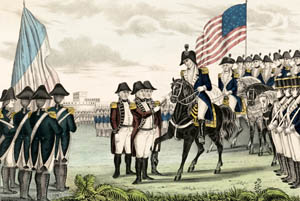
Major General Charles Cornwallis surrendered in Yorktown, Virginia.
Major General Charles Cornwallis, 1st Marquess Cornwallis, and 2nd Earl Cornwallis served as British generals during the American Revolution. Notably, he surrendered his army to General Washington’s Continental Army and the Allied French forces at Yorktown, Virginia, in October 1781. This surrender effectively ended hostilities between British and American forces and led to peace negotiations, ending the war and recognizing American independence. Cornwallis later governed in India.
Margaret Corbin (1751-1800), a patriot camp follower, manned a cannon at the battle of Fort Washington in 1776, taking over from her husband when he was mortally wounded. After suffering serious injuries herself, she was later awarded a military pension.
Philip Van Cortlandt served as a commander in the Continental Army during multiple campaigns of the American Revolution. Later in life, he served as a New York State assemblyman, a state senator, and as a representative for the state in the U.S. Congress.
Charles Cotesworth Pinckney was a signer of the U.S. Constitution, veteran of the American Revolution, and Federalist presidential candidate. He provided the young nation with long and dedicated public service. A southern planter, he also worked to protect the interests of slaveholders in the young republic.
Captain Davis of Acton was the first Colonial officer to die in the American Revolution. He died on April 19, 1775, when he led his company of minute men in the advance against the British regulars at British regulars at Concord’s North Bridge.
John Dickinson (1732-1808), the “Penman of the Revolution,” was the most famous of the Founders to come from Delaware. His principled stand for colonists’ rights in the Revolution’s early years won him praise and recognition for his writing skills. However, he would later stand against the Declaration of Independence. Dickinson, like many others, also believed in abolition, and yet still enslaved people on his plantation.
Hanyerry Doxatader was a Native American Warrior and ally of the new United States during the American Revolution. He fought at Oriskany and Saratoga in New York and dined with George Washington at Valley Forge, Pennsylvania. His leadership helped secure the Oneidas as America’s “First Allies” in the history books.
William Henry Drayton, a wealthy planter and politician, became one of the loudest Whig voices in 1774 and 1775, advocating for a new government and separation from Great Britain in 1776. He significantly negotiated a neutrality truce with leading loyalists in the South Carolina backcountry in 1775, allowing South Carolina to focus on her defense from British forces. He died in Philadelphia of typhoid in 1779 while serving in the Continental Congress.
Prince Dunsick was an African man who was kidnapped as a child, enslaved in Massachusetts, and enlisted in the Continental Army. His story is representative of so many forgotten soldiers of African descent who fought in the American Revolution on behalf of a nation that didn’t always recognize them.
Prince Estabrook was an enslaved man who lived in Lexington, Massachusetts. On April 19, 1775, he stood on the town green with his white neighbors as the British army marched towards them. He was wounded in the shoulder. He recovered and served as a soldier over multiple deployments during the war. He survived the war and lived out the rest of his days as a free man.
Reverend William Emerson served as a minister in Concord, Massachusetts, from 1765 to 1776. The political unrest between the American colonies and the British Parliament defined his time in Concord. His ardent belief in the American cause inspired his community to resist and take action. On April 19, 1775, his community found itself at the center of the storm when a force of 700 British soldiers marched to Concord to seize and destroy military supplies.
Caesar Ferrit was a Caribbean immigrant who fought at Lexington, Massachusetts, alongside the Patriot militia on April 19, 1775. Caesar settled in Natick, Massachusetts, and was said to have “the blood of four nations,” African, Indigenous, French, and Dutch.
Benjamin Franklin (1706-1790) was a leading diplomat, scientist, and inventor of the 18th century and one of the most famous of the Founding Fathers. He made many discoveries about electricity, invented the lightning rod, bifocals, and a type of stove known as a Franklin stove. He was a significant figure in Philadelphia, Pennsylvania civic life, creating a university and fire department. He was also a spokesman for the colonies, who played a crucial role in creating the Declaration of Independence and convincing the French to ally with the new country.
Christopher Gadsden, a leading voice in South Carolina for independence, played a prominent role in the American Revolution as an officer in the Continental Army and a politician. His career as a merchant also influenced Charleston, contributing to the city’s wealth. His business interests included a large harbor, which played a significant role in Charleston’s place in the trans-Atlantic slave trade.
Thomas Gage (1719-1787) was the military governor of Massachusetts in 1774. His actions in trying to enforce the Intolerable Acts created the conditions that led to the Battles of Lexington and Concord. He was also the general in charge of the British side at the Battle of Bunker Hill, where he won but with heavy losses. In 1775, he was replaced by General William Howe.
Peter Gansevoort was only 28 years old when he led the American Fort Schuyler through a siege by British forces in 1777. His fort became the only American fort to never surrender while under attack by the British during the American Revolution.
Horatio Gates, a former British army officer, settled in Virginia in the 1770s and volunteered for service with the Continental Army after the American Revolution began. Gates commissioned a major general and famously commanded the northern army that defeated British General John Burgoyne’s army at Saratoga in 1777, a significant turning point in the war. Gates, a favorite of Congress, was later assigned to the Southern Department, where his military career ended in defeat at Camden.
Father Pierre Gibault, Vicar General of the Illinois Country, in 1778 and 1779, gained the allegiance of the French population of Vincennes, Kaskaskia, and Cahokia to the United States of America.
William Gifford was a young man when he joined the Continental Army. He witnessed and participated in the events surrounding the Siege of 1777. He later fought in the War of 1812.
Nathanael Greene assumed the arduous task of Quartermaster General during the Valley Forge winter encampment. He later commanded the Southern Department after Horatio Gates and led the army at the Battle of Guilford Courthouse on March 15, 1781. Commander-in-Chief George Washington said that if he perished during the Revolution, he wanted Major General Nathanael Green to replace him.
Richard Gridley served as Chief Engineer during the Battle of Bunker Hill (1775) and the fortification of Dorchester Heights (1776). He is recognized as the 1st Chief Engineer of the United States Army Corps of Engineers. He was an engineer and artillerist during the Battle of Bunker Hill and the Siege of Boston and as a British officer before 1775.
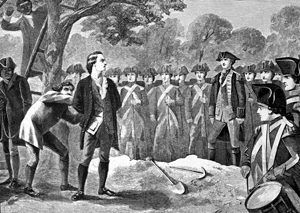
Hanging of Nathan Hale
Nathan Hale (1755-1776) was an American soldier whom the British executed. His famous last words before being hanged were, “I only regret that I have but one life to give for my country.”
Sarah Josepha Hale, a writer and editor, greatly impacted American middle-class culture and gender identity.
Alexander Hamilton (1857-1804) was the first Secretary of the Treasury, a chief of staff to George Washington during the Revolution, and founder of the Federalist Party. Hamilton established the financial system of the United States and was instrumental in creating the first national bank. He was shot and killed in a duel with then Vice-President Aaron Burr in 1804
John Hancock (1737-1793) was most famous for his elegant signature on the Declaration of Independence. He lived a life near the political center of Boston. His wealth and popularity led to a highly successful political career and a place as one of the Founders of the United States and the president of the Second Continental Congress.
Mary Hartwell was the wife of Samuel Hartwell, 1st Sergeant of the Lincoln Minuteman Company. April 19, 1775, was a day Mary would remember for the rest of her life. Her actions that day have left historians with somewhat of a mystery.
Zopher Hawkins was only 19 years old when he joined the Continental Army. In 1780, he became a captive and prisoner of war. He lived until age 91.
Lemuel Haynes (1753-1833), America’s first abolitionist writer, was a free Black man born to a white mother and an African American father. A soldier in George Washington’s Continental Army, he had just finished writing an essay called Liberty Further Extended — one of the world’s first anti-slavery pamphlets. When he read the Declaration of Independence, he liked the phrase ”all men are created equal” so much that he used it to open his essay — thus becoming the first person to quote what are now the Declaration’s five most iconic words. Haynes and other anti-slavery activists read the Declaration as promoting personal freedom. Those abolitionists and 19th-century women’s rights campaigners eventually convinced their fellow Americans to see our founding document the way all Americans do today: a universal declaration of human rights.
Adam Helmer, a hero of the Mohawk Valley during the American Revolution, undertook a 30+ mile run in 1778 to warn American settlements of a pending attack. His run became immortalized in the novel “Drums Along the Mohawk.”
Patrick Henry (1736-1799) was a spokesman in favor of independence before the American Revolution. He is famous for his speech where he said, “Give me Liberty or Give me Death!”. He was also the leader of the Anti-Federalists during the Philadelphia Constitutional Convention in 1787.
General Nicholas Herkimer was the commander of the Tryon County Militia. He led his troops through the Battle of Oriskany, dying himself ten days later.
General William Howe (1729-1814) was one of the Commander-in-Chiefs of the British army during the American Revolution. He took control of British forces after the Battle of Bunker Hill in 1775 and captured New York City and Philadelphia. He resigned his post in 1778 in response to his poor planning of the Saratoga, New York campaign undertaken by General John Burgoyne, whose failure led to the entry of France into the conflict on the side of the United States.
Isaac Huger, a Continental Army officer, served in the southern theater during the American Revolution and fought at notable battles, including the Battle of Guilford Courthouse, where he was wounded.
Faith Trumbull Huntington was an accomplished artist and a beloved mother, wife, daughter, and sister. In 1775, Faith witnessed the Battle of Bunker Hill while visiting her brother, John Trumbull. The experience of witnessing the battle sent Faith Trumbull Huntington into a severe depression, which led to her suicide. Faith’s story reminds us of war’s effect on civilians and soldiers.
William Jasper, the famous Revolutionary War soldier, served in the Second South Carolina Regiment, fighting in the Battle of Sullivan’s Island and the Siege of Savannah, where he was mortally wounded.
John Jay (1745-1829) was a Founding Father, governor of New York, and the first Chief Justice of the United States Supreme Court. Jay was a Federalist and played a significant role in creating and helping to ratify the Constitution. Together with James Madison and Alexander Hamilton, he wrote the Federalist Papers. He was also responsible for the abolition of slavery in New York State.
Thomas Jefferson’s (1743-1826) growing reputation for politics earned him a chance to represent Virginia at the Second Continental Congress in 1776. Jefferson was the youngest member of the Continental Congress at only 33 years old. Jefferson’s fellow representatives called upon his talents by selecting him to compose the Declaration of Independence.
Thomas Jeremiah, a wealthy free person of color, was hanged for his alleged involvement in an enslaved insurrection to support the British government by South Carolina’s patriots in August 1775, the first South Carolinian to die as a result of the American Revolution. During the revolution, Jefferson continued his role as a prominent politician, serving in the Virginia state government and greatly assisting with formulating the state constitution.
Prince Johonnot enlisted in Andover, Massachusetts, in Captain John Davis’ Company, Colonel James Frye’s Regiment, and was at the Battle of Bunker Hill in the redoubt. Twenty-five-year-old Prince Johonnot was one of the 119 patriots of African or Native American ancestry who fought in the first battles of the American Revolution. As a former enslaved person, his courage and duty at the Battle of Bunker Hill marked the beginning of a life of commitment.
Lady Mary Watts Johnson was born into a life of prosperity, comfort, and high society. Mary (nicknamed “Polly”) had no way of knowing how quickly her life would change forever as she grew into a young woman. Civil wars like the American Revolution can divide families in ways none would ever imagine and lead those who would not usually be considered soldiers to fight battles not for grand causes but to keep their families together. Such is Mary Watts Johnson’s story.
John Paul Jones (1747-1792) was a prominent naval officer who was sometimes called the Father of the United States Navy during the American Revolution.
Seargent William Jones joined the Continental Army at the outset of the American Revolution. H was at the American Fort Schuyler/Stanwix during the Siege of 1777 and saw combat at the 1779 Battle of New Town. Despite serving well for three years, Jones eventually left the new United States for Canada, never returning to the original nation he sided with.
King George III (1738-1820) was the King of Great Britain from 1760-1810. During his long reign, he fought many wars, including the French and Indian War, the Revolutionary War, and the Napoleonic Wars. He was the tyrant described in the Declaration of Independence who sought to restrict the legitimate rights of American colonists. In the later part of his life, he suffered from an unidentified mental illness.
Samuel Kirkland was a missionary whose friendship with the Oneida people led them to side with the American cause during the Revolution. He was also the founder of Hamilton College.
Henry Knox (1750-1805) was the Chief artillery officer of the Continental Army. Active with Washington throughout most of the war, he brought Ticonderoga’s cannons to Boston in early 1776 and saw the most action from New York to Yorktown. He oversaw the creation of an artillery training center that was a precursor to the United States Military Academy and later served as the first United States Secretary of War.
John Laurens, born to a wealthy planter family in South Carolina, received a republican education in Switzerland and England. Upon his return to South Carolina to fight in the American Revolution, he radically proposed to recruit slaves as soldiers in return for their freedom. An aide-de-camp to General Washington and later a lieutenant colonel of the Continental Army with a field command, he served bravely in many key battles, only to die in a meaningless skirmish in 1782.
Charles Lee, a former British Army officer, became the second-highest-ranking general of the Continental Army during the American Revolution. On June 28, 1776, he oversaw the victory at the Battle of Sullivan’s Island in Charleston, SC. Two years later, his retreat on the field at the Battle of Monmouth Courthouse would result in his court martial and the end of his military career. Learn more about this controversial figure here.
Henry Lee, III (1756-1818), nicknamed Light-Horse Harry, was a cavalry officer in the American army during the Revolutionary War. He later served as Virginia’s governor and as a U.S. Congress representative. He was the father of Confederate General Robert E. Lee.
Alexander Lemmon was an Irish immigrant who joined the Continental Army in 1775, fought in the attack of Quebec, and survived the Siege of 1777. Although not many details of his life are known, the personal descriptions in his story show the humanity of all the forgotten soldiers of the American Revolution.
Alexander Leslie, a British Army officer, served throughout the American Revolution, playing significant roles in battles during the British capture of New York. He later oversaw the British evacuation of Savannah, Georgia, and Charleston, South Carolina, in 1782 as the war neared its conclusion.
Barzillai Lew enlisted in Chelmsford, Massachusetts, in Captain John Ford’s company, Colonel Ebenezer Bridge’s 27th regiment, and was a soldier, fifer, and drummer.
Benjamin Lincoln, a major general of the Continental Army, was present at pivotal moments in the American Revolution. He oversaw the Continental Army’s largest defeat when he surrendered 5,000 soldiers to the British in Charleston, South Carolina, in May 1780. After being exchanged, he returned to the army and was at the allied Franco-American victory at the Siege of Yorktown. He accepted the surrender of General Charles O’Hara’s sword.
James Madison (1751-1836) was the fourth President of the United States. He was called the Father of the Constitution and Father of the Bill of Rights for his role in drafting documents and his work in ratifying them. He was one of the authors of the Federalist Papers, along with Alexander Hamilton and John Jay.
Francis Marion, the “Swamp Fox,” challenged British rule in the South Carolina backcountry after the Continental Army’s defeat at Camden in August 1780. His militia used guerrilla warfare to frustrate British efforts to mobilize loyalists in the Georgetown District. Marion, formerly a Continental Army officer, coordinated effectively with the Continental Army in the field.
Thomas Mifflin (1744-1800) served in various roles during and after the American Revolution, several qualifying him to be counted among the Founding Fathers. He was the first Governor of Pennsylvania, serving from 1790 to 1799, and the last President of Pennsylvania, succeeding Benjamin Franklin, serving from 1788 until 1790.
Gilbert du Motier, the Marquis de Lafayette (1757-1834), served with George Washington in the Philadelphia campaign. He fought in the Battle of Rhode Island and successfully resisted significant engagements with British forces in Virginia before the armies of Washington and Rochambeau arrived. He was a favorite of Washington’s, who treated him like a son.
Joseph Plumb Martin enlisted in the Continental Army in 1776 and served, with one short break, through the siege of Yorktown in 1781. His memoir of the war, published in 1828, serves as a valuable account of a common soldier’s experience during the American Revolution, offering a first-person perspective of some of the famous engagements of that conflict.
The Martin Women were strong women of the South Carolina Backcountry during the American Revolution.
Arthur Middleton, a wealthy planter and South Carolinian delegate to the Continental Congress signed the Declaration of Independence and helped frame the Articles of Confederation. After the British capture of Charleston in 1780, Middleton was sent to St. Augustine, British East Florida as a prisoner of war. Upon his release and exchange, he recommitted himself to the patriot cause.
William Moultrie’s 2nd South Carolina Regiment successfully defended Charleston Harbor from the Royal Navy in the Battle of Sullivan’s Island on June 28, 1776. This Patriot victory began a meteoric rise for Moultrie as he achieved the rank of general and later served South Carolina as governor.
Thomas Nelson, Jr. served in many roles during the American Revolution. A signer of the Declaration of Independence, Nelson left the Continental Congress to serve as a militia officer in his native state of Virginia. In 1781, the legislature appointed him the fourth governor of Virginia to organize the state’s military defense against British attack. After taking part in the siege of Yorktown, Nelson retired from active service, suffering from poor health.
George Noteware was a “Brunswicker,” a German soldier who fought for Great Britain during the American Revolution. He found himself captured by the Americans in the aftermath of the Battle of Saratoga, spent the year as a prisoner, and decided to join the Continental Army.
Thomas Paine (1737-1809) was a professional revolutionary activist who was influential in the American and French Revolutions. In 1776, he wrote a pamphlet titled Common Sense, which firmly laid out the need for independence from Great Britain. It was considered then and now to be one of the most influential works that rallied the colonists to support breaking with England. After the American Revolution, he moved to France to pursue the Revolution there. He wrote a defense of the French Revolution known as “The Rights of Man” in 1791. He returned to the United States in 1802, where he lived isolated and rejected by the public.
Admiral Sir Peter Parker, a veteran Royal Navy officer, commanded a naval attack on patriot fortifications on Sullivan’s Island in June 1776. Shockingly defeated by an amateur American force, Parker later served under Lord Richard Howe in the invasion and capture of New York City. From 1777 to 1781, he served as commander-in-chief in Jamaica. Numerous prestigious promotions in the navy and service in Parliament marked his postwar career.
Andrew Pickens, a significant commander of the patriot militia in South Carolina during the American Revolution, led operations against the Cherokees and loyalists in the early years of the war. Following the surrender of Charleston, he collaborated effectively with the Continental Army against the British at Cowpens, Augusta, Ninety-Six, and Eutaw Springs. After the Revolution, he pursued a political career, including a term in the U.S. House of Representatives.
Thomas Pinckney, like his brother Charles Cotesworth Pinckney and his cousin Charles Pinckney, fought for American independence during the Revolution and served the young United States of America capably as a politician and diplomat. As minister to Spain, Pinckney guaranteed Americans access to the Mississippi River at New Orleans, Louisiana, in the Treaty of San Lorenzo.
Salem Poor has remained one of the few fabled African American heroes of the Revolutionary War since 1775 due to his strength and stability at the Battle of Bunker Hill. Officers present at the Battle of Bunker Hill (June 17, 1775) submitted a petition to General George Washington describing his outstanding battle abilities.
Othniel Preston II joined the Continental Army in 1776. In August of 1777, he found himself in the 3rd New York Regiment and under siege by British forces. During that same time, his father fought and died for the British cause at the Battle of Bennington. The story of Othniel Preston and his family illustrates the complexities of the fighting during the American Revolution. Entire families ended up fighting and dying on opposite sides of the conflict.
Francis Lord Rawdon, later Francis Rawdon-Hastings, Earl of Moira, was an Irish-Anglo army officer and politician who served the British empire faithfully from service as a young man throughout the American Revolution through the French Revolutionary Wars, capping his career with a decade as Governor-General of India.
Esther de Berdt Reed (1746-1780) served as the First Lady of Pennsylvania during her husband Joseph Reed’s term as governor from 1778 to 1780. She was active in the American Revolutionary War as a civic leader for soldiers’ relief. She published Sentiments of an American Woman, which called for financial sacrifice and an increased role for women in public service. Along with Sarah Franklin Bache, the daughter of Benjamin Franklin, she co-founded the Ladies Association of Philadelphia, which raised money to provide resources for George Washington’s troops during the war. She was recognized as a member of the Daughters of Liberty post-mortem for supporting the American Revolution.
Paul Revere (1734-1818) was an ardent supporter of the American Revolution and an accomplished silversmith. He is best remembered for alerting the militia in Massachusetts of the approach of British forces before the Battles of Lexington and Concord. He is best remembered for alerting the militia in Massachusetts of the approach of British forces before the Battles of Lexington and Concord. After the Revolution, he established a successful foundry and copper mill. A public-spirited citizen, Revere was also ambitious and often brash, which he embraced during his Revolutionary and post-Revolutionary life.
James Robinson was a Black veteran who served in the Revolutionary War and the War of 1812 while enslaved.
Lieutenant Colonel George Rogers Clark was involved in the Revolutionary War in the Western Theater.
Isaac Roosevelt was a sugar merchant whose opposition to British trade laws and their reduction of profits drove him to the Revolutionary cause. Isaac served in the New York State Assembly and was a member of the State Constitutional Convention of 1788. He was the great-great-grandfather of Franklin D. RooseveLieutenant.
Betsy Ross (1752-1836) is credited with making the first American flag in 1776 at the request of George Washington.
Seth Rowley II enlisted in the Continental Army at the age of 16. He witnessed the Siege of 1777, the execution of British spy Major John Andre, and one of the last campaigns of the war in 1783.
Edward Rutledge was the youngest signatory of the Declaration of Independence. Despite his youth, he had already made a name for himself in South Carolina as a lawyer and politician and had assumed leadership of his congressional delegation. A moderate, he fought against the independence resolution but finally submitted to the majority and voted for it. His later state career, which included combat action in the militia, culminated in the governorship.
John Rutledge, lawyer, politician, and jurist, notably led South Carolina as her longest war-time governor during the American Revolution. Rutledge was one of four South Carolinian delegates to the Constitutional Convention in 1787 and helped defend the interests of the southern slave-holding elite.
Deborah Sampson, the daughter of a poor farmer, disguised herself as a man and enlisted in the Continental Army at the age of 21. Under the alias of Robert Shurtleff, Sampson demonstrated bravery in battle, working side-by-side with other soldiers. Sampson went to extreme measures to remain undetected. In one instance, she extracted a bullet from her thigh by herself. However, after almost two years of service, a severe fever rendered her unconscious, and a doctor discovered her secret.
General Philip Schuyler was commander of the Northern Department of the Continental Army, father-in-law to Alexander Hamilton, and a heavy investor in the early New York canalways.
Shenandoah was a long-lived chief of the Oneida Nation. His friendship with specific American Patriots swayed the Oneidas to the American cause during the American Revolution, causing them to become the “First Allies.”
Cato Smith was an enslaved African who was brought to Massachusetts Bay from Ghana in 1761 at the age of 10. In 1775, he was enslaved to the family of Captain William Smith of Lincoln. On April 24, 1775, he enlisted in the Massachusetts Army as a soldier and served until the end of the year. He enlisted again in late summer 1776 and died in service on January 23, 1777.
Major Caleb Stark, the son of General John Stark, served during the American War for Independence, most notably at the Battle of Bunker Hill. His eight years of service led him to later advocate for the rights of war veterans.
Nicholas Stoner was a veteran of America’s first two wars. As a young man, when he enlisted in the Continental Army. While enlisted, he participated in many historic events. Later, he joined the military again to fight in the War of 1812.
Thomas Sumter, the Carolina Gamecocks, led the South Carolina militia to resist British rule from 1780 through 1781, keeping the Patriot cause alive.
Banastre Tarleton, a British army officer, famously commanded the British Legion, a provincial regiment composed of loyalist infantry and dragoons, in the southern theater under Lord Cornwallis during the Revolution. Feared for his ruthlessness by the patriots, his early successes in the field earned him notoriety. Defeated at the Battle of Cowpens by Brigadier General Daniel Morgan, Tarleton’s favor with Cornwallis declined. Tarleton was present at the surrender at Yorktown.
Hannah Till was an enslaved cook and servant to General George Washington during the Valley Forge encampment in 1777-78. She purchased her freedom during the American Revolution and continued to work as a salaried cook.
William Tryon was the last British Provincial Governor of New York and North Carolina.
Tyonajanegen, or “Two Kettles Together,” was a fierce woman who accompanied her husband, other Oneida warriors, and American militias fighting in the American Revolution.
Colonel Goose Van Schaick was the commander of the 1st New York Regiment. He led his regiment through New York, Fort Stanwix, and Onondaga Territory.
Darby Vassall (1769-1861) was an active member of Cambridge and Boston’s community and a dedicated abolitionist whose activism spanned the American Revolution to the earliest days of the Civil War.
Francis Vigo was a Spanish Trader who warned Clark that the British had taken Fort Sackville and planned to attack him come the spring.
Friedrich Wilhelm Ludolf Gerhard Augustin von Steuben, a drillmaster of the Continental Army, joined General Washington’s troops at the Valley Forge encampment in the winter of 1877 and put them through proper military training, creating a newer, more effective, and more professional Continental Army in the process.
Rachel Walker married Paul Revere in October 1773, when he was already involved in Boston’s Revolutionary organizations. When he became the “Messenger of the American Revolution” two months later, she took on most of the responsibility for their “blended family” during difficult times.
Joseph Warren, a Founding Father of the United States, was an American physician who was one of the most influential figures in the Patriot movement in Boston during the early days of the American Revolution. He was, undoubtedly, the hero of the Battle of Bunker Hill, and by dying on that hill that June day in 1775, he became the embodiment of the young nation’s sacrifice.
George Washington (1732-1799) was perhaps the one indispensable man among the founders. He was the Father of the Country, Commander in Chief of the Continental Army, and the First President of the United States. He established government traditions such as the inaugural address, the cabinet system, and the tradition of only serving two terms.
William Washington, a cavalry officer in the Continental Army during the American Revolution, achieved fame for his role in the Southern theater, contributing significantly to the victory at the Battle of Cowpens.
Mad Anthony Wayne – (1745-1796) An accomplished military commander during the American Revolution, General Wayne helped win our independence from Great Britain. Called out of retirement by President George Washington, Anthony Wayne reorganized the U.S. Army. He defeated a confederacy of American Indian nations in the Old Northwest at the Battle of Fallen Timbers in 1794, resulting in the Treaty of Greenville, which opened Ohio to white settlement.
Cuff Whittemore was present at Battle Road in Captain Benjamin Locke’s militia. He later enlisted in Arlington, Massachusetts, in Captain Benjamin Locke’s company, in Colonel Thomas Gardner’s regiment, and was present at the Battle of Bunker Hill in the redoubt.
Marinus Willett was a Continental officer during the American Revolution. He was called upon for service in the Mohawk Valley multiple times during the war.
Hunloke Woodruff was a prominent surgeon and physician during the American Revolution and in his chosen home in Albany, NY. He was known as a skilled physician and generous neighbor. During the Siege of 1777 at Fort Schuyler, he was the American garrison’s primary doctor and treated several dozen injuries.
Private Sampson Yearney of Medford, Massachusetts, was a free man of color who enlisted for service during the American Revolution. Sampson served multiple enlistments and died in service near Peekskill, New York, on March 7, 1779.
Compiled by Kathy Alexander/Legends of America, February 2024.
Also See:
Heroes and Patriots of America
Sources:
History Extra
Lloyd Sealy Library
National Park Service
Texas A&M University
Time
Wikipedia


